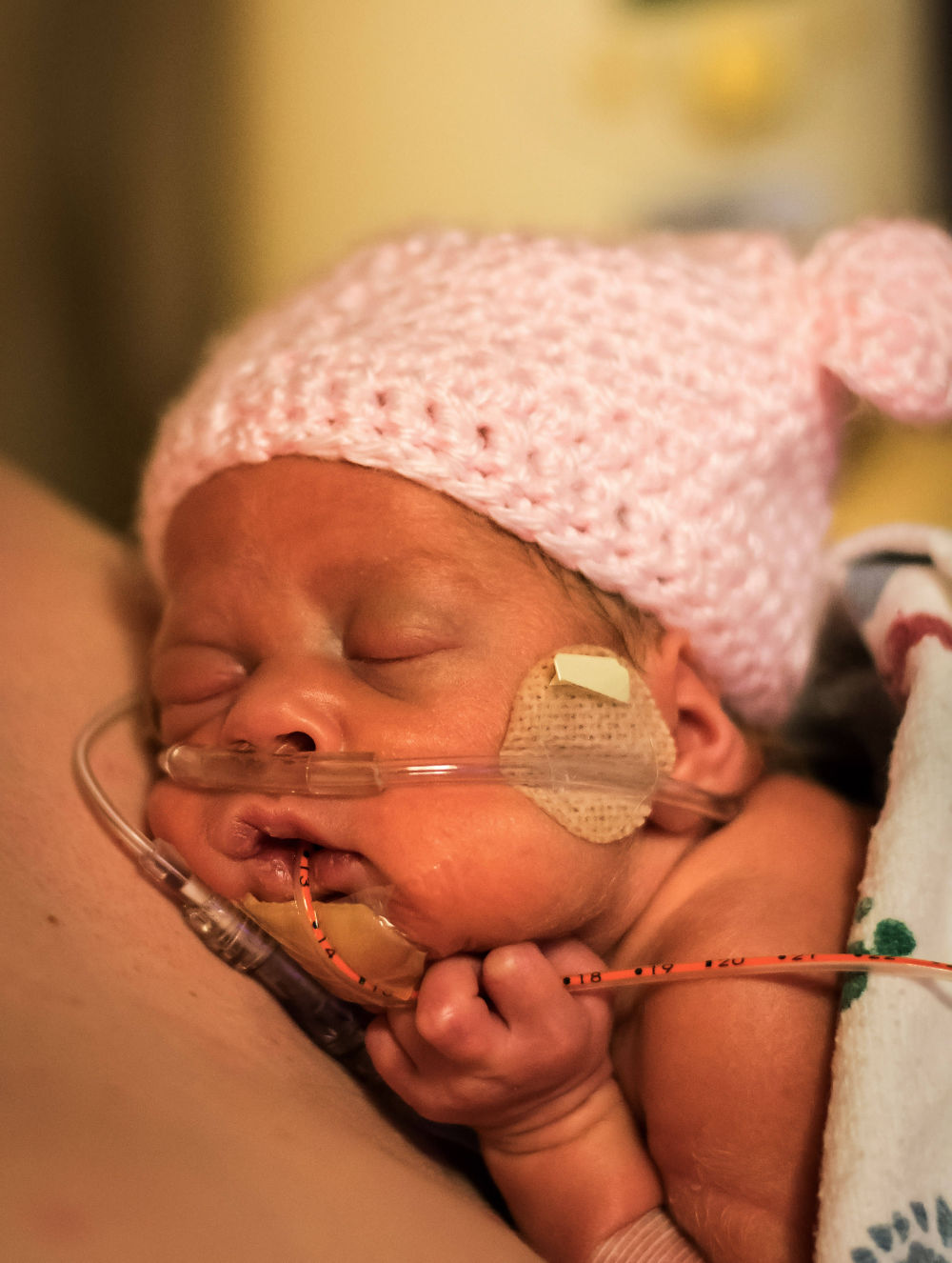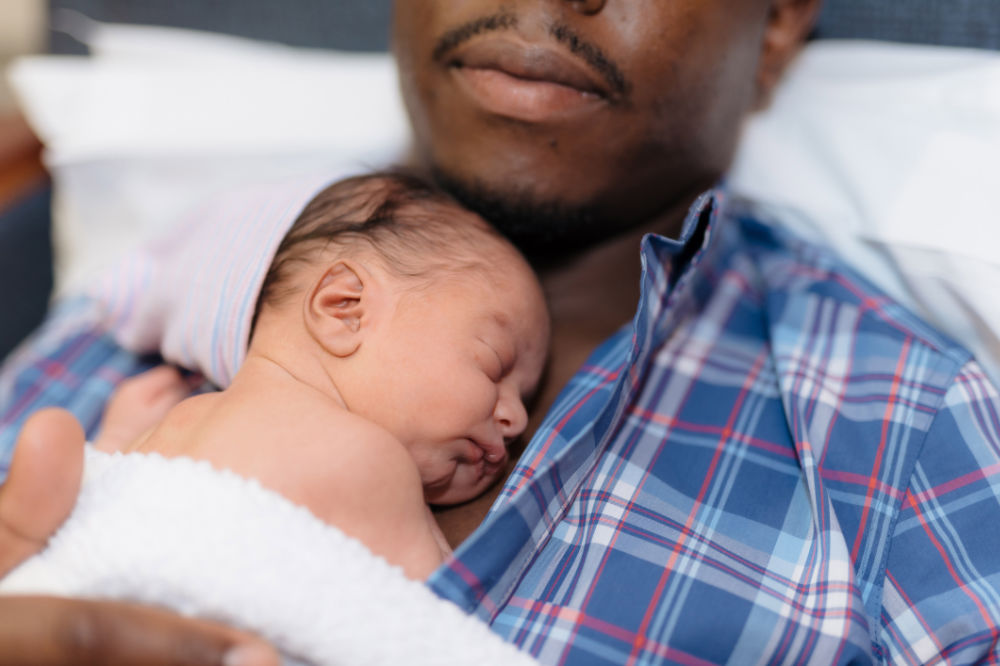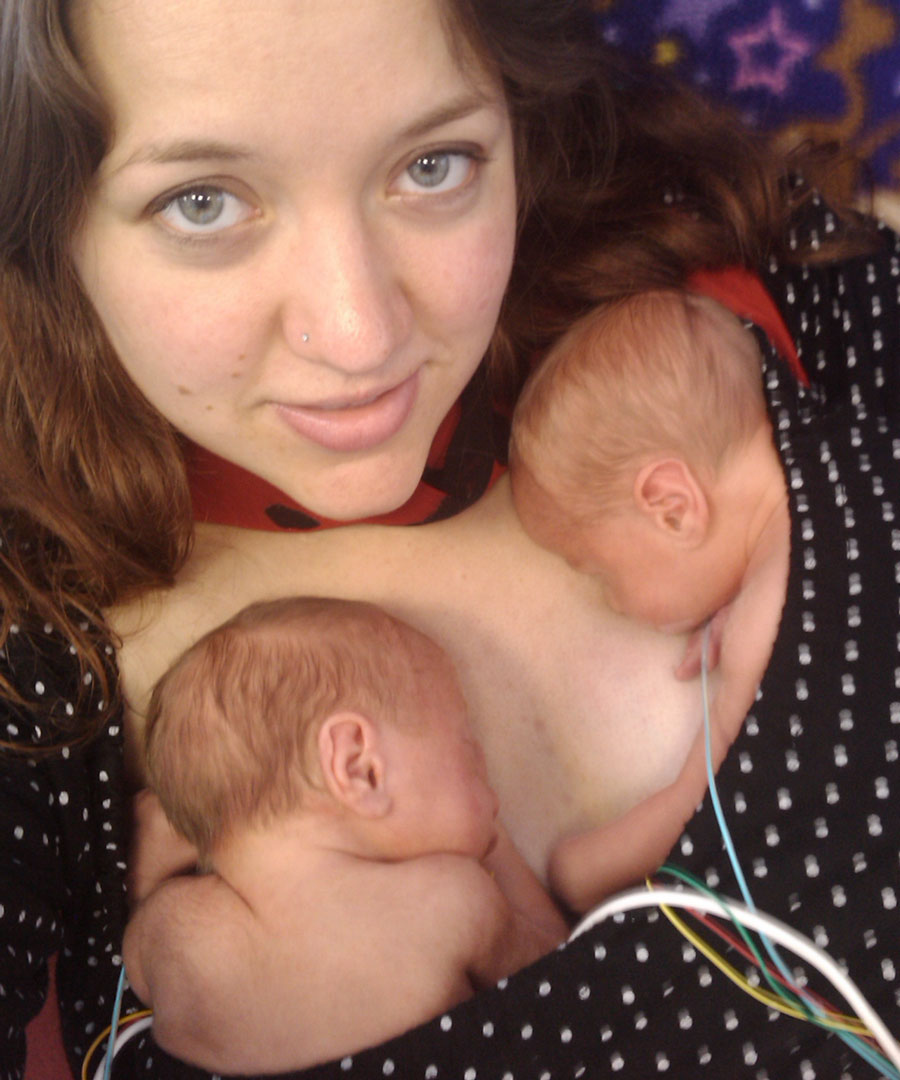Kangaroo mother care (KMC) or kangaroo care is the name given to caring for a newborn baby in continuous skin-to-skin contact; snuggled against their mother’s (or substitute carer’s) chest. Ideally the baby will also be exclusively fed breast milk. When carried in skin-to-skin contact with his mother, the newborn baby feels safe and calm and instinctively searches for the breast to latch and breastfeed. Not only is kangaroo care very helpful to breastfeeding success, it has many other advantages for the vulnerable premature baby from improving survival outcomes to promoting healthy brain development and reducing stress.
This article
This article discusses why kangaroo care works, the advantages to mother and baby, and how to do it. The emphasis in this article is on the benefits of kangaroo mother care for premature babies however skin-to-skin contact is beneficial to all newborns. This is a companion article to Breastfeeding a Premature Baby and Why Skin-to-Skin?

Why kangaroo care?
The name “kangaroo care” is taken from how kangaroos (and other marsupials) rear their young. Kangaroo babies are born very early in their development and crawl into a special pouch on the outside of the mother’s body—where they breastfeed and continue to develop. Kangaroo mother care similarly uses skin-to-skin contact and the mother’s body to nurture a premature baby. The close contact of KMC recreates the conditions closest to those in the womb and helps to stabilise a baby more quickly12 and improve their health3. Although additional technology and medical care may be needed to help the little premature baby, this can usually be combined with KMC at the same time.
In the womb (uterus) a baby is constantly nourished and firmly held, sounds are muffled, lights are dimmed, his fragile skin is protected by fluid and his lungs and brain can steadily prepare for independent life. By contrast, it is very stressful for a premature baby to find himself thrown into a world of bright lights, harsh sounds and separation from his mother. In the neonatal care unit (NICU) babies may twitch, change colour, have an uneven heart rate and breathing, be tense, fussy, get very tired and they are aware of being separated from their mother. Kangaroo mother care recreates the conditions closest to the womb and helps to stabilise the baby more quickly.

When can kangaroo care start?
The sooner a premature baby can have kangaroo care, the sooner it helps them adapt to life outside the womb:
- KMC helps premature babies stabilise their heart rate, breathing and temperature, it reduces their stress levels which helps them establish breastfeeding sooner and grow faster (Bergman, 2010).
- KMC can stabilise babies faster than an incubator. Recent research across five hospitals in Ghana, India, Malawi, Nigeria, and Tanzania showed low birth weight babies who received immediate kangaroo mother care had better survival outcomes than babies receiving conventional care in an incubator to stabilise before having kangaroo mother care.4
- Premature babies can begin to breastfeed from 28 weeks gestation but kangaroo care can get started before this, even while a baby still needs oxygen or intravenous fluids, and will help to get breastfeeding established earlier (Bergman, 2010). See Breastfeeding a Premature Baby for more information about breastfeeding.
Skin-to-skin contact should be for every baby at birth
Some say that the baby must stabilise in the incubator first and then have skin-to-skin contact. But this is a problem as babies do not stabilise in an incubator for days, they do stabilise in skin-to-skin contact.
The smaller the prem, the more they need their mother’s chest to stabilise even if they need medical technology as well
Advantages of kangaroo care
Kangaroo care improves survival outcomes and a baby’s resilience (ability to maintain healthy emotional functioning) to stress.5 Benefits include:
#1 More stable
In kangaroo care the feelings of safety and security provided by the mother’s body stabilise (regulate) the baby’s body functions. In skin-to-skin care; the baby’s heart rate, blood pressure and temperature stabilise, oxygen saturation is more stable, breathing is better with less episodes of apnoea, and baby experiences better quality sleep than in incubator care. This increased stability means a premature baby is less stressed, cries less and is better able to digest food to grow (see #3 below).678
Temperature regulation
A mother’s chest regulates a baby’s body temperature more consistently than an incubator. Breasts can warm a baby if he is too cold and cool him down if he is too warm.9
#2 More sleep
Sleep is very important to the premature baby for their brain development, emotional health, memory and growth. The premature baby sleeps soundly on his mother but he cannot sleep properly in an incubator (Hold Your Prem, Bergman, 2010). Holly Richardson explains:
During kangaroo care, a premature baby’s overall growth rate increases. This is in part due to the baby’s ability to sleep, thus conserving energy and putting caloric expenditure toward growth. According to Dr. Ludington, during the last six weeks of pregnancy, babies sleep twenty to twenty-two hours per day. In a typical NICU, however, they spend less than two hours total in deep, quiet sleep. Most of that comes in ten or twenty second snatches. With kangaroo care, the infant typically snuggles into the breast and is deeply asleep within just a few minutes. These babies gain weight faster than their non-kangarooed counterparts, and it is interesting to note that they usually do not lose any of their birthweight.
#3 Less crying, less stress, more resilience
Separation from the mother is stressful and a separated baby will cry for his mother. Crying is extremely stressful for a premature baby and uses up precious calories. The loss of the stability provided by the mother’s body is thought to cause growth hormone to be switched off, and the baby’s body systems to become disregulated. The stress hormone cortisol can alter brain development with long lasting effects (see #5 below)10 and the increased blood pressure can contribute to the brain bleeds common in premature babies (Bergman, 2010). When crying increases a baby’s heart rate and blood pressure, this can open a valve between the two sections of the baby’s heart, so that deoxygenated blood could be sent to the brain instead of the lungs. By caring for a baby in kangaroo care, there is less crying so that a baby is better able to cope with any stress that he does encounter11 and the baby has better resilience and health12.
For prematures they need mother EVEN more to stabilise. Instead they are taken to ICU, given sugar, put in incubator with bright lights, loud sounds, with strange smells of disinfectant etc. They cry and we have MADE THEM WORSE by separating them from mum.

#4 Better digestion, more growth
In kangaroo care a premature baby has less of the stress hormones somatostatin and cortisol. Presence of somatostatin slows down the gut and so the baby’s growth rate. In addition, skin-to-skin contact may promote the release of digestive hormones.13 Jill Bergman explains:
In skin-to-skin contact [SSC], the baby is in a relaxed mode so all her hormones prepare her gut to absorb food maximally. SSC babies can grow at 30g per day which is twice the rate of an incubator baby. Skin-to-skin care will mean less time in hospital.
See Breastfeeding a Premature Baby for more references on weight gain.
#5 Optimal brain development
- Brain growth is as important as physical growth for the premature baby. Healthy brain development is “fired and wired” by what a baby feels, senses and digests, this in turn shapes a baby’s emotional development. The close presence and touch of the mother (or substitute) is therefore vital for a premature baby’s brain to develop normally (Bergman, 2019; Bergman et al. 2019). A baby who is separated from his mother in an incubator is in a very different environment to being carried inside the mother during pregnancy. Kangaroo mother care can bridge the gap—providing the stimulation to the baby’s senses needed for healthy brain development by creating an emotional connection to their mother and the ability to hear their mother’s voice and heart beat, touch, smell, and see her and taste breast milk.
- Breast milk also contains 200 or more “non protein nitrogens” to correctly build the human brain and gut and provide immunity. Cows’ milk, in contrast has only 2% of these non protein nitrogens (Bergman, 2010). See Breastfeeding a Premature Baby and Human Milk Fortifiers for more information about nutrition for a premature baby.
#6 Helps breastfeeding and health
Carrying your baby in kangaroo care has many advantages to breastfeeding; breastfeeding usually starts more easily 14, more breast milk is produced, feeds are more frequent, there is better digestion and faster weight gain. Breastfeeding also supports a significant decrease in diseases such as pneumonia, septicaemia and necrotising enterocolitis.15 16
#7 More bonding
Kangaroo care can help parents bond and interact with their baby, feel empowered and more confident because they are able to help with their baby’s care. Skin-to-skin contact releases more oxytocin which helps with feeling calm and with mother’s milk supply. Mothers can feel less depressed, less stressed and better able to cope with having a premature baby when they care for their baby by this method17 18 while the increased bonding in kangaroo care helps long term emotional health 19.

#8 Financial savings
Kangaroo care can create substantial financial savings to families and health care facilities thanks to less reliance on technology, parents carrying out much of their baby’s care and shorter hospital stays 20.

How to do kangaroo care
A baby wearing only a nappy and a little hat (if needed) while held under his mother’s clothes next to her breasts allows full skin-to-skin contact for kangaroo care. If the mother is not available a substitute care-giver can do kangaroo care. The more skin-to-skin care your baby can have the better. Jill Bergman advocates firm holding or “containment” as feather-light touch or stroking can irritate a baby’s sensitive skin.
Video from Global Health Media
The following video from Global Health Media explains the benefits of skin-to-skin for small babies and describes how to wrap a baby to the mother’s chest and position them safely. The video includes important warning signs to watch out for that might suggest your baby needs medical care.
Step-by-step
Jill and Nils Bergman explain how to do kangaroo care step-by-step in How to do KMC (excerpt below):
Your baby only needs a tiny nappy and cap.
Wash your hands well every time you come to your baby. Use plain soap without any perfumes.
Mum, take off your bra but keep your shirt on, it is easiest if you have one that buttons down the front. Put your baby inside, against your skin.
Sit in a chair with cushions so you can lean back a bit and be comfortable. It is best for your baby if you are half lying, half sitting. The angle of 30-40 degrees helps her breathing. Place your baby on your chest facing you with her legs curled up in the foetal position. This is best for her hips. Put her tiny hands near her face for self-soothing. She has been doing that for months in the womb already. You can hold your hands underneath and behind her.
Cover her and yourself. Your body will automatically warm up if your baby is cold or will cool down if your baby is hot. You might find that you start to sweat, don’t worry, that is normal.
See the full article for more tips on successful kangaroo care including how long to hold your baby to get the most benefit, how to position your premature baby’s head so they can breathe easily during kangaroo care and how to navigate your baby’s sleep cycles. Nils Bergman advocates for as much skin-to-skin contact as possible—kangaroo care 24 hours a day is ideal to minimise stress for your baby—and this can be shared between a baby’s parents/care givers21.

Summary
Kangaroo mother care is an important part of the care of a premature baby whatever the medical setting. Not only does it help stabilise a baby’s body systems and promote breastfeeding, it has important benefits for a baby’s brain development and their physical and emotional health. Kangaroo care is an extension of skin-to-skin contact and involves the mother or another care giver holding the baby as much as possible around the clock. Kangaroo care is beneficial to all newborn babies not just premature babies.